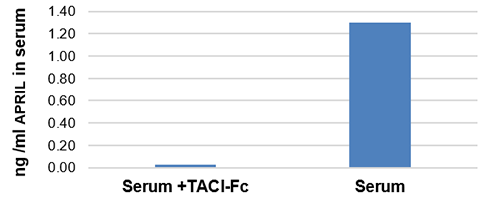APRIL (human) ELISA Kit
| Code | Size | Price |
|---|
| AG-45B-0012-KI01 | 96 wells | £540.00 |
Quantity:
Prices exclude any Taxes / VAT
Overview
Regulatory Status: RUO
Target Species: Human
Shipping:
Blue Ice
Storage:
+4°C
Images
Further Information
Alternate Names/Synonyms:
A Proliferation Inducing Ligand; Tumor Necrosis Factor Ligand Superfamily Member 13; TNFSF13; TALL-2; CD256
Assay Type:
Sandwich
Detection Type:
Colorimetric
EClass:
32160000
Handling Advice:
After standard reconstitution, prepare aliquots and store at -20°C.Avoid freeze/thaw cycles.Plate and reagents should reach room temperature before use.
Long Description:
ELISA assay. Detects human APRIL in serum, plasma and cell culture supernatant. Colorimetric sandwich assay. Sample Type: Cell Culture Supernatant, Plasma, Serum. Range: 3.9 to 250pg/ml. Sensitivity: 1pg/ml. APRIL is a cytokine that belongs to the TNF superfamily and binds to TACI and BCMA. It is implicated in the regulation of tumor cell growth, is involved in monocyte/macrophage-mediated immunological processes and functions as an important survival factor for plasmablasts and bone marrow plasma cells.
NCBI, Uniprot Number:
O75888
Package Type:
Box
Product Description:
APRIL is a cytokine that belongs to the TNF superfamily and binds to TACI and BCMA. It is implicated in the regulation of tumor cell growth, is involved in monocyte/macrophage-mediated immunological processes and functions as an important survival factor for plasmablasts and bone marrow plasma cells.
Range:
3.9 to 250pg/ml
Sample Type:
Cell Culture Supernatant, Plasma, Serum
Sensitivity:
1pg/ml
Specificity:
Detects human APRIL in serum, plasma and cell culture supernatant.
Transportation:
Non-hazardous
UNSPSC Category:
ELISA Kits
UNSPSC Number:
41116126
Use & Stability:
12 months after the day of manufacturing. See expiry date on ELISA Kit box.
References
APRIL limits atherosclerosis by binding to heparan sulfate proteoglycans: D. Tsiantoulas, et al.; Nature 597, 92 (2021)



